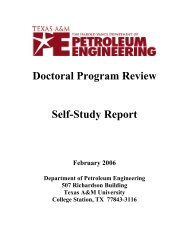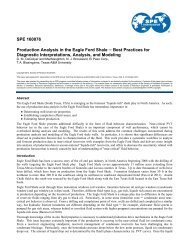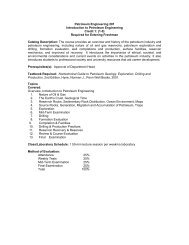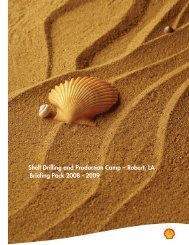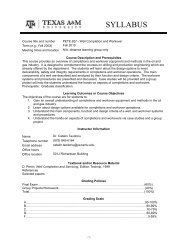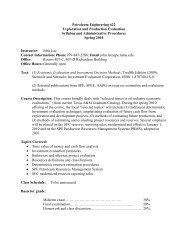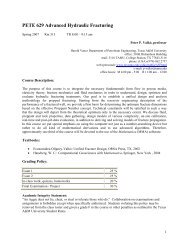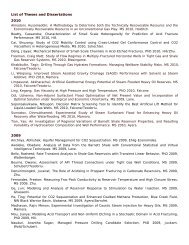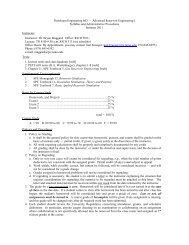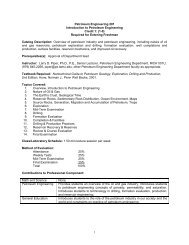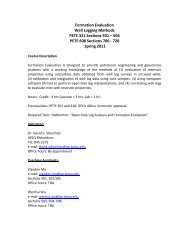Crisman Annual Report 2009 - Harold Vance Department of ...
Crisman Annual Report 2009 - Harold Vance Department of ...
Crisman Annual Report 2009 - Harold Vance Department of ...
You also want an ePaper? Increase the reach of your titles
YUMPU automatically turns print PDFs into web optimized ePapers that Google loves.
Improved Permeability Predictions using Multivariate Analysis Methods<br />
Introduction<br />
Predicting rock permeability from well logs<br />
in uncored wells is an important task in<br />
reservoir characterization. Due to the high<br />
costs <strong>of</strong> coring and laboratory analysis,<br />
typically cores are acquired in only a few<br />
wells. Since most wells are logged, the<br />
common practice is to estimate permeability<br />
from logs using correlation equations<br />
developed from limited core data. Most<br />
commonly, permeability is estimated from<br />
various well logs using statistical regression.<br />
For sandstone reservoirs, the logarithm <strong>of</strong><br />
permeability can be correlated with porosity,<br />
but in carbonate reservoirs the porositypermeability<br />
relationship tends to be much<br />
more complex and erratic.<br />
Objectives<br />
In order to improve the permeability estimation in<br />
complex carbonate reservoirs, several statistical<br />
regression techniques have been tested in previous<br />
work to correlate permeability with different well<br />
logs (Lee, Arun and Datta-Gupta, 2002; Mathisen,<br />
Lee, and Datta-Gupta, 2003). It has been shown<br />
that statistical regression for data correlation is quite<br />
promising, but using all the possible well logs to<br />
predict permeability may not be appropriate because<br />
the possibility <strong>of</strong> spurious correlation increases as<br />
more well logs are used. Therefore, the objective<br />
<strong>of</strong> this study is to further improve permeability<br />
prediction by selecting appropriate well logs for data<br />
correlation via variable selection procedures.<br />
Approach<br />
In statistics, variable selection is used to remove<br />
unnecessary independent variables and give a more<br />
robust prediction. We will apply variable selection<br />
methods to the permeability prediction procedure<br />
to improve permeability estimation. Specifically,<br />
we have proposed a new method combining the<br />
stepwise regression with Alternating Conditional<br />
Expectation (ACE) techniques and will compare the<br />
proposed method with two other methods: the tree<br />
regression and the Multivariate Adaptive Regression<br />
Splines (MARS) method.<br />
Accomplishments<br />
Three methods are tested and compared using data<br />
from a complex carbonate reservoir in west Texas:<br />
Predicted vs. Measured<br />
MSE=1.9728 MAE=1.0682 =0.68227<br />
10 -2 10 -1 10 0 10 1 10 2 10 3<br />
Measured permeability<br />
the Salt Creek Field Unit (SCFU). The results <strong>of</strong><br />
SCFU show that the stepwise regression with the<br />
ACE method outperforms the other two methods in<br />
permeability prediction. The figure shows the result<br />
<strong>of</strong> the stepwise regression with the ACE method vs.<br />
true permeability for a blind test data set.<br />
Project Information<br />
3.2.13 Improved Permeability Predictions using Multivariate<br />
Analysis Methods<br />
Related Publications<br />
Lee, S. H. and Datta-Gupta, A. 2002. Electr<strong>of</strong>acies<br />
Characterization and Permeability Predictions in Carbonate<br />
Reservoirs: Role <strong>of</strong> Multivariate Analysis and Non-parametric<br />
Regression. SPE Reservoir Evaluation and Engineering 5<br />
(3): 237-248. DOI 10.2118/78662-PA.<br />
Mathisen, T., Lee S. H., and Datta-Gupta, A. 2003.<br />
Improved Permeability Estimates in Carbonate Reservoirs<br />
Using Electr<strong>of</strong>acies Characterization: A Case Study <strong>of</strong> the<br />
North Robertson Unit, West Texas SPE Reservoir Evaluation<br />
and Engineering 6 (3): 176-184.<br />
Contacts<br />
Akhil Datta-Gupta<br />
979.847.9030<br />
a.datta-gupta@pe.tamu.edu<br />
Jiang Xie<br />
Depth<br />
6220<br />
6240<br />
6260<br />
6280<br />
6300<br />
6320<br />
6340<br />
6360<br />
6380<br />
6400<br />
6420<br />
Measured<br />
permeability<br />
Permeability vs. Depth<br />
CRISMAN INSTITUTE<br />
Predicted<br />
permeability<br />
Permeability Predictions from Well logs Using Stepwise Regression with ACE (Alternating<br />
Conditional Expectations) for the Salt Creek Field Unit, West Texas.<br />
<strong>Crisman</strong> <strong>Annual</strong> <strong>Report</strong> <strong>2009</strong><br />
77



